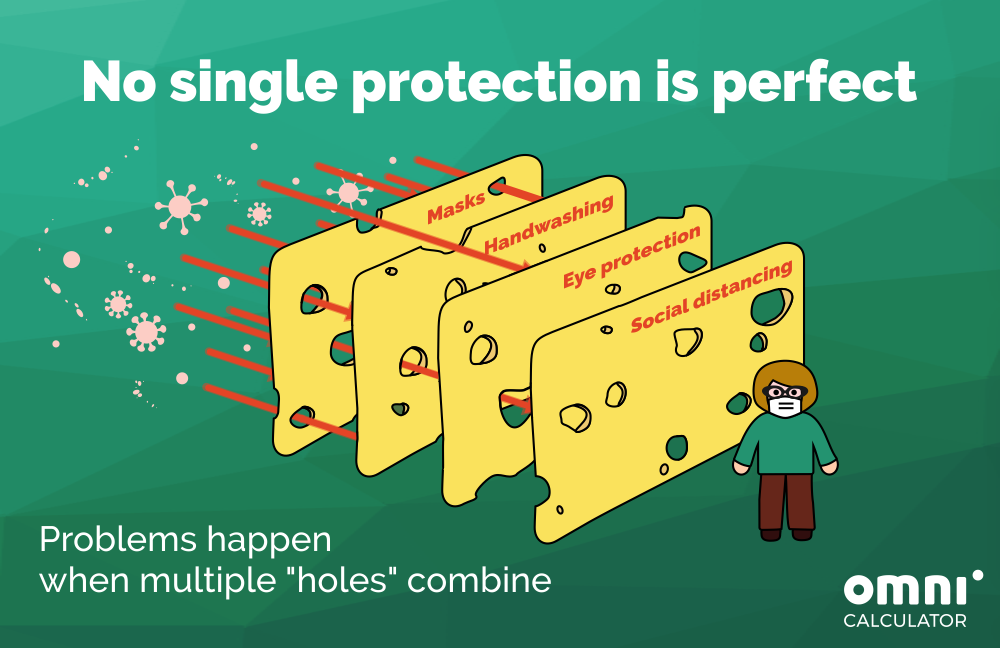Coronavirus Protection - Swiss Cheese Model
The coronavirus pandemic has affected over globally and resulted in over one million deaths. Its consequences are not measured only as a fatality rate - lockdowns resulting in shutting down businesses, social restrictions, isolation, and stress have been shared by everybody now. Many of us experience disappointment and distrust in the authorities because the situation has lasted for so long now, and nobody came up with a better idea than 'wear a mask'. kicks in, and we feel like we've lost control of our lives completely, and there's nothing we can do.
But is that true?
We've built this calculator to show that not everything is lost, and we can act now. We have got some power in our hands that, appropriately used, can build up to incredible results. as a pile of Swiss cheese slices - slices being the interventions we implement. The cheese separates us from the virus and keeps us and our environment safe. The more slices we add to our life, the more protected we and others around us are.
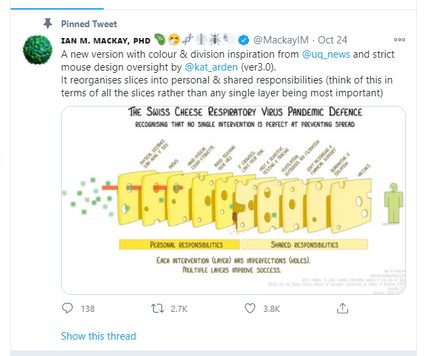
(last updated Nov 2020)
Experts' call to action - "We need to act now"
Recently published article, - one of the most important texts on COVID-19 until now, states:
The evidence is very clear: controlling community spread of COVID-19 is the best way to protect our societies and economies until safe and effective vaccines and therapeutics arrive within the coming months. We cannot afford distractions that undermine an effective response; it is essential that we act urgently based on the evidence.
How do we control the community spread? By disrupting and blocking the transmission paths, that means:
- Wearing masks;
- Wearing eye protection;
- Caring about hand hygiene; and
- Proper distancing ourselves from other people.
Let's see what The Lancet consensus says again:
Transmission of the virus can be mitigated through physical distancing, use of face coverings, hand and respiratory hygiene, and avoiding crowds and poorly ventilated spaces. Rapid testing, contact tracing, and isolation are also critical to controlling transmission. WHO has been advocating for these measures since early in the pandemic.
As we see, there are actions and interventions on various levels. Contact tracing and rapid testing are not our job and do not depend on us, but everybody can wear a mask. Everybody can learn to wash their hands properly. You can wear a mask; you can wash your hands. You can save lives.
Do not lose that superpower.
Swiss cheese model for coronavirus explained
There are very few things in life that are 100% sure, and coronavirus protection ways are no exception. No matter how expensive your mask is, how hard you try to avoid coming near people during shopping, there is always a risk that something would go wrong.
No single protection is perfect. Every intervention has its stronger and weaker sides.
In the Swiss cheese coronavirus model, we compare single interventions to slices of Swiss cheese. Slices have multiple holes (weaknesses), but if you pile them together, the holes have very little chance of lining up (getting sick). Therefore, you will be protected in the end, even though technically there are some holes in your set of slices.
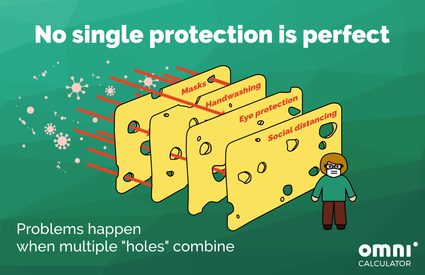
The more layers you combine, the smaller the risk of the whole set failing, and the smaller the chances of getting infected. What is even more important is that most of those interventions are things that you can do on your own with no problem, no great cost, and no big effort. You are in control of your mask you wear, your hand hygiene, and keeping an appropriate distance, and a sense of control might be a soothing thought during those crazy times.
The model also stresses the fact that all the interventions are complementary, not substituable. In other words, washing your hands 50 times a day will have its anti-infectious effect, but not as big as combining washing hands 20 times a day AND wearing a mask. So don't think that by washing your hands like crazy, you don't need to wear a mask anymore.
, Sterling Professor of Social and Natural Science at Yale, summed it up on his Twitter:
'In order to stop the spread of the SARS-Cov-2 and substantially reduce the risk of the Covid-19 epidemic in a family, firm, or nation, one just needs enough layers of Swiss cheese, but not necessarily all of them.'
How this calculator works
In the calculator, we wanted to show how seriously you can affect your infection risk.
Our calculator simulates two people encountering each other and estimates the risk of getting infected for one of them. Then, it shows you the result as a risk reduction that you have made following the safety recommendations. This way, the tool displays how much you can do on your own, with no great costs and no effort.
- See the panel on your left.
- Fill in the 'Me' section. Check if you're using a mask (correctly - only properly worn mask (covered mouth and nose, tightly fit your face) counts as 'worn' in this calculator.), if you wash your hands regularly and if you have eye protection.
- Then, fill in 'The other person' section with similar questions.
- Check if you're keeping a proper distance. The CDC informs about the 'six feet rule', but even one meter plays in your favor.
- You'll see the result immediately, together with short comments.
- Make sure to check the text to find out more!
For calculating the risk decrease, we searched through the scientific papers to find out to what extent a single piece of personal protective equipment works. We've expressed it as something working using coefficients. Coefficient is a number showing how many times your risk is diminished while using a particular way of protection. Our calculator numbers are 4 for a mask, 1.49 for handwashing, 2.9 for eye protection, and 4.92 for keeping a distance.
Then we let the initial risk be 1. We divide it by all the coefficients that apply. For example, if you wear a mask (4) and wash your hands (1.49), the other person wears a mask (4), and you know nothing about her hygiene habits (so we reckon the worse version and set the coefficient to 1, so it doesn't affect the result). However, there's a distance of 4 meters between you two (4.92), because you're responsible.
[1 / (4 * 1.49 * 4 * 1 * 4.92)] = (1/117.293) = 0.0085256
This value represents a statistical chance of getting infected with all those precautions. However, we prefer to show your impact on the situation, and we tell you how much safer you are converting it to percents:
(1 - 0.0085256) * 100% = 99.15%
In this situation, you're 99.15% safer than when nobody uses personal protective equipment or follows the recommendations of keeping the distance and hand hygiene. Good job!
Be in control of your health & protect the others.
How do all these layers protect us?
Personal protective equipment is often distrusted. We believe that if we understand how something works, why it is useful, and see why it makes sense to use it, we will naturally be more confident about it. So let's make clear for ourselves why it is worth applying some interventions to our everyday lives.
1) Masks 😷
Masks are probably the most discussed way of slowing the spread of the pandemic down. The reason is that it personally touches us, as a mask is another thing we have to remember about, we have to put it on our face directly, and most of us are not used to covering our mouths and noses on a daily basis. But now we know for sure - and , recommending the majority of people wear them.
Masks work for both sides: they protect the wearer and others around them.
-
The wearer - if worn correctly - with the edges fitting your face, covering both your mouth and nose - the mask works as a filter for the air that you inhale.
-
Other people - masks are a way of source control since they are a barrier between a contagious person and other people. The mask traps infectious pathogen droplets in the material of the mask.
But does it mean masks are meant for the sick, symptomatic patients? The answer is no.
First, there are moist droplets, possibly with pathogens, in the air that we exhale all the time. That's how we catch a common cold - we don't need to be exposed to a coughing person. It could be just this one innocent chat with our sick-to-be colleague. We inhaled the infectious particles, they laid on our nose and throat tissues, and bah - we're sick. The amount of excreted particles raises if we cough, sneeze, talk loudly, shout, sing.
Second, COVID-19 has many faces (meaning clinical symptoms), and, unfortunately, one of them is a poker face. that even 80% of persons tested positive for SARS-CoV-2 are asymptomatic. That means we should consider adapting medical workers' approach and realize that everybody is possibly infectious - including ourselves. Covering our mouth and nose will protect the people around you and slow down the disease's spread.
There is a variety of masks available on the market:
- Cloth masks - cheap, available, reusable, and you can even make one yourself. They block only some of the virus particles, still for everyday use and they're eco-friendly.
- Surgical masks require frequent changing and cannot be reused; they also block only part of the viral load.
- N95/N99 respirators and masks with N95/N99 filters - significantly more expensive than previous types of masks, recommended for professional medical use. They block up to 99% of virus particles.
Find out, how many lives you can save wearing a mask (learn more about it at our coronavirus mask calculator) and how many of them do you need to stay safe over a period of time.
One last important thing: a shield is not equal to the face mask. A face mask is way more effective at blocking contagious droplets, whereas a shield just forces the air to change its way further from your face. Recently the government of , also .

Face shield is an eye protection equipment, not a mask equivalent.
2) Handwashing 🧼
Sometimes it's good to be back to basics. We can wear an N95 respirator, a fancy face shield, but if we forget about simple, old handwashing - we're done. In 2017, proved that handwashing has a significant protective effect against flu. We can even convert handwashing's importance to money. The annual cost of diarrhea and respiratory tract infections due to poor hand hygiene is estimated at .
Handwashing works as simple as it sounds - it just washes the germs away from your hands. And your hands are a particular hot spot because you touch almost everything around you with them. You touch garbage, you touch the food that you're going to eat, you touch your closest ones, you touch many frequently-touched objects like doorknobs, buttons in an elevator, light switches, and finally - you touch your face about 20 times per hour. Since *, let's at least have our hands clean.
- Touching your own face is inescapable while being human. It's an act of self-kindness and plays a key role in all cognitive and emotional processes. Even fetuses in utero do it a lot. And, unfortunately, .
How to wash your hands? :
- Wet your hands with clean, running water (warm or cold), turn off the tap, and apply soap.
- Lather your hands by rubbing them together with the soap. Lather the backs of your hands, between your fingers, and under your nails.
- Scrub your hands for at least 20 seconds. Need a timer? Hum the "Happy Birthday" song from beginning to end twice.
- Rinse your hands well under clean, running water.
- Dry your hands using a clean towel or air dry them.
When water-and-soap handwashing is not an option, you can use a hand sanitizer containing at least 60% alcohol. You should rub it to all parts of your hands, and during the process, hands should be wet all the time - otherwise, the sanitizer's action is not guaranteed. Avoid it when your hands are visibly dirty or greasy, as sanitizer doesn't work like soap, and it won't lift the germs and dirt from your skin’s surface (yes, that's how the soap works - lifts the microbes so the water can wash them away).
How often to wash your hands? In our calculator, we aim for at least ten times a day, and this is the number supported by research. It might seem a lot, but looking at the list of situations when handwashing is recommended, it's not hard to reach this 'safety level'.
The critical times to wash your hands are:
- Before and after preparing your food, before eating;
- after using the toilet or changing a baby's diaper;
- After arriving home, playing outside;
- after coughing, blowing your nose, sneezing - also after caring for someone who is sick;
- after playing with animals.
3) Eye protection 🥽
As masks and handwashing stand for two fundamental pillars of protecting yourself from COVID-19, in June 2020, a spotlighted the eye protection equipment role. The subject was widely discussed, and also the USA's top infectious diseases expert, , took the floor. In July, he had an interview with Dr. Jennifer Ashton on Instagram live, who asked him about his views on a few COVID-related questions.
His opinion on eye protection is straight: if you really want perfect protection [...], theoretically you should protect all the mucosas, if you have goggles or an eye shield, you should use it '.
Dr. Fauci mentioned mucosas. Mucosa, or mucous membrane, is a membrane that lines cavities of our body - e.g., gastrointestinal tract, intimate parts, respiratory tract, our nose, oral cavity, and eyes. And to make it as simple as it could be - mucosas are naturally wet, so if a tiny droplet containing SARS-CoV-2 falls on it, the virus is likely to multiply and spread. On the other hand, the risk of getting infected after contaminating a non-injured hand skin with coronavirus-containing droplets is almost impossible (reckoning you don't rub your nose).
That's why eyes are a gate of infection, and that's why it's worth protecting the eyes - mechanically separating them from the possible virus particles afflux.
The eye protection examples are 👍 :
- goggles;
- face shield;
- safety glasses.
The eye protection examples ARE NOT 👎 :
- prescription eyewear;
- sunglasses;
- reading glasses;
- contact lenses.
However, in ordinary life (meaning non-healthcare environment), eye protection equipment is mostly recommended for those who come into contact with many people (restaurants, shops) or have to work closely with others. Regarding Dr. Fauci's opinion, you should consider it if you're at high risk of severe COVID disease. Estimate the risk in your case with our COVID mortality rate calculator.
4) Physical distance 📏
At the early stage of the pandemic in March, one of the first safety measures and advising people to stay at home as much as possible. Lockdown was just a means to achieve social isolation, which means to separate people from each other and prevent spreading the infection. That was brutal but an effective way to flatten the curve.
However, lockdown couldn't last forever, and reopening is a necessity and an economic and social need. That's when we all got to know the 'six feet rule '.
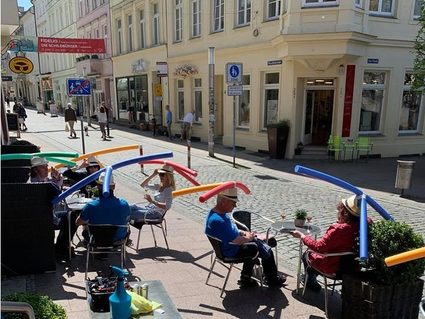
Physical distance works simply - you try to escape the 'field of fire' of the virus by moving away from potentially contagious people - that means, everyone.
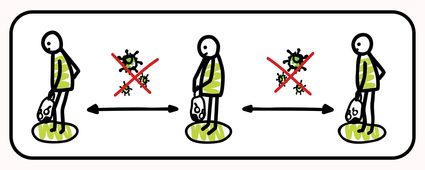
The right distance is a matter of discussion. The original six feet rule comes from studies that began in 1897, when a distance of 1-2 meters (3.3-6.6 feet) was proposed as safe, based on the observation of visible pathogen-containing droplets after sneezing and coughing. Now scientists know much more and . Phenomena like trapping infectious particles in the exhaled moist air, movement of the gas cloud, specific airflow, viral load (how many virus particles there are in the exhaled air), and many more. Thus their opinion is, we should see the physical distance as one of the parts of the safety approach during the pandemic, and we need to complement it with other behaviors: wearing proper masks and hand hygiene at least.
(If you're interested, check out the - including the type of vocal activity, distance, presence of face mask, occupancy, and ventilation quality.)
However, the study we use shows measurable benefits from physical distancing even for even 1 meter, and for further distance, the effect probably increases. That's why in building the calculator, we've implemented the distance between two persons. There might be no one precise distance over which you cannot be infected, but definitely, the bigger, the better.
How to live?
Breathe in, breathe out (when in a safe space), put your slices together, and keep going.
We can beat this pandemic together. It will take time and pounds of Swiss cheese, but we will.
References
K Chu, D.; A Akl E.; Duda, S., et al. - Physical distancing, face masks, and eye protection to prevent person-to-person transmission of SARS-CoV-2 and COVID-19: a systematic review and meta-analysis (June 2020)
Jefferson, T.; Foxlee, R.; Del Mar, C. et al. - Physical interventions to interrupt or reduce the spread of respiratory viruses: systematic review (July 2011)
Howard, J.; Huang, A.; Li, Z. et al. - Face Masks Against COVID-19: An Evidence Review (July 2020)
Esposito, S.; Principi, N.; Leung, C.; Battista Migliori, G. - Universal use of face masks for success against COVID-19: evidence and implications for prevention policies (June 2020)
Rabie, T.; Curtis, V. - Handwashing and risk of respiratory infections: a quantitative systematic review (March 2011)
Aiello, A.; Coulborn, R.; Perez, V.; Larson, E. - Effect of hand hygiene on infectious disease risk in the community setting: a meta-analysis (June 2008)
Jones, N.; Qureshi, Z.; Temple, R.; Larwood, J. Greenhalgh, T.; Bourouiba, L. - Two metres or one: what is the evidence for physical distancing in covid-19? (August 2020)
Brooks, J.; Butler, J. Redfield, R. - Universal Masking to Prevent SARS-CoV-2 Transmission—The Time Is Now (July 2020)
Ing, A.; Cocks, C.; Green, J. - COVID-19: in the footsteps of Ernest Shackleton (May 2020)
Chughtai, A.; Seale, H.; Macintyre, C. - Effectiveness of Cloth Masks for Protection Against Severe Acute Respiratory Syndrome Coronavirus 2 (October 2020)
Saunders-Hastings P.; Crispo, J.; Sikora, L.; Krewski, D. - Effectiveness of personal protective measures in reducing pandemic influenza transmission: A systematic review and meta-analysis (September 2017)
Townsend, J.; Greenland, K.; Curtis, V. - - Costs of diarrhoea and acute respiratory infection attributable to not handwashing: the cases of India and China (January 2017)
Kwok, Y.; Gralton, J.; McLaws, M. - Face touching: a frequent habit that has implications for hand hygiene
Alwan, N.; Burgess, R.; Ashworth, S.; Beale, R.; Bhadelia, N.; Bogaert, D. et al. - Scientific consensus on the COVID-19 pandemic: we need to act now (October 2020)
DISCLAIMERS
- The data referring to the extent of risk reduction were partly extrapolated from studies on SARS , MERS, influenza and respiratory tract infections.
- Getting infected is too multifactorial to be calculated in any calculator; we know about ways to reduce the risk and have the data to present the average extent of protection, but this is still statistics, and in real life, you might or might not get infected regardless of the calculator results.
The more slices (ways of protection) you have, the less chance of the holes coinciding and the safer you are.
